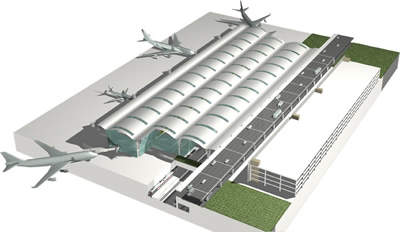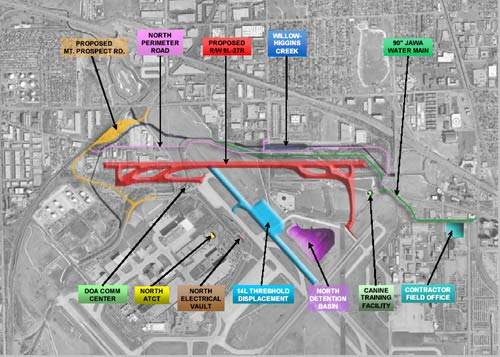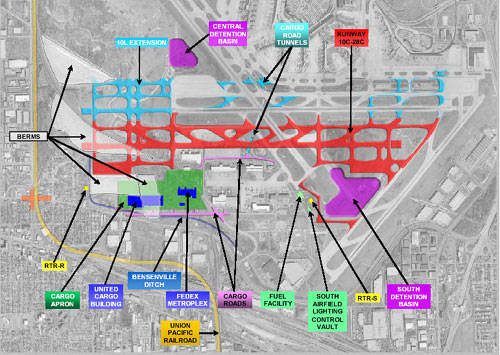Chicago O’Hare (ORD) is one of the busiest airports in the US, being a major international and domestic hub for some of the largest carriers in the world (including United Airlines and American Airlines).
The smooth running of operations at this airport is of paramount importance to schedules right across the US – delays at O’Hare can cause major disruptions. The major problem is the unpredictable mid-western weather, which means thunderstorms in summer and spring and major snow and ice in winter that can lead to runway closures.
The layout of the airport runways is also a major factor; all but one of the seven runways on the 7,300-acre airport intersect, and bad weather results in more runways being closed than if the runways were laid out in a better configuration. The airport consistently has to lose a third more capacity than it should because of bad weather and poor layout. Delays caused by Chicago O’Hare Airport are now part of American folklore.
The modernisation plan is estimated to cost $15bn. The city is funding the project through a mix of Federal dollars, airport revenue bonds and passenger fees.
The project was scheduled to start in early 2006, subject to FAA approvals, and be completed in 2015. A series of court cases brought by the residents of Elk Grove and Bensonville, who are due to be displaced because of the expansion, had held up the project. However, it began in September 2005 and is currently underway, although many court cases are still pending.
Debate and opposition
There has been much debate over what to do about the airport’s problems since the plans were first mooted in 2002.
One lobby (Suburban O’Hare Commission – a committee of displaced residents) insisted that the only thing to do is to build a new airport at Peotone about 45 miles south of Chicago – these include two groups: the local county government and another backed by US Rep. Jesse Jackson Jr D-Ill – which includes Montreal-based SNC-Lavalin America Inc and LCOR Holdings).
The other lobby insisted that the problems can be solved at O’Hare and that the airport needs a major revamp and expansion programme, which would involve seven new runways and a new terminal.
The winning lobby was the revamp and expansion as the Illinois General Assembly has passed the O’Hare Modernisation Act (August 2003 signed into law), which approves the City of Chicago’s O’Hare expansion programme.
All of the contractors were in place by the end of 2005 and the final land acquisitions are still under negotiation; the approval of the Federal Aviation Administration (FAA) was obtained in August 2005 (the FAA wanted the expansion work carried out in a different order, the priority being the construction of the Lima Lima taxiway to service the 10/28 centre runway to increase safety standards). A runway incursion (i.e. two planes having a near miss on the ground) occurred in August 2006 and this has galvanised support for the expansion.
Supporters of the expansion plan say delays could be cut by 79% and that 195,000 jobs and $18bn would be put into the local economy. In 2004 the airport played host to 69.5 million arriving, departing and connecting passengers and had nearly 929,000 total aircraft operations, an average of one landing or take-off every 56 seconds. With the American and United hubs, 60% of O’Hare’s passengers make connections there.
The airport has 178 gates on eight connected concourses and one freestanding terminal. The realignment and modernisation programme could make a great deal of difference to the efficiency of the airport. The future airfield will be able to accommodate approximately 1.6 million aircraft operations and 76 million enplanements a year.
O’Hare modernisation plan (OMP)
The plan involves the reconfiguration of the runway system so that it is similar to the layout at Fort Worth, Texas. The realignment will involve the construction of new runways, closure of others and also runway extensions.
Four runways will be replaced by runways 9L/27R (opened in 2008), 9C/27C, 10C/28C (grading work proceeding) and 10R/28L. The three runways to be decommissioned include 18/36, 14L/32R and 14R/32L. The runways to be extended are 9L/27R and 9R/27L (in future to be designated as 9R/27L and 10L/28R, respectively). Runways 4L/22R and 4R/22L would also be retained for operational flexibility.
The two longest runways would then be 13,000ft and the two shortest 7,500ft. The first of the runways to be constructed was 9L/27R (the city has already acquired the land necessary to complete this and the cost would be $565m).
The plan would also see the new west terminal and remote concourse, a 1.5-million-square-foot, 60-gate terminal at the western edge of the property linked to the existing gates by an underground airport transit system and Terminals 3 and 5 undergoing some degree of expansion.
A new access road on the western side and relocation of part of the Union Pacific railway was completed by October 2008. The final project is the south airfield detention basin. The site preparation for the south detention basin site was completed by May 2007. The programme will expand the airport’s capacity to over 3,800 operations a day and will vastly increase passenger throughput capacity.
The existing terminal and the remaining airport facilities will benefit from a capital improvement programme at the same time, so that the airport can present a new face to the public when all the work is complete. The city is spending $300m to update the existing terminals, adding 20ft to the fronts of the international Terminal 2 and American Airlines Terminal 3 for more lobby and circulation space and building a canopy over two lanes of the departure roadway. This program began in 2005 and was originally scheduled to be complete by 2007. Additional work required will include:
- 3,800 new short-term public parking spaces near the new west terminal
- 3,200 new long-term parking spaces on the southwest side of the airport
- Additional employee parking lots
- Secured automated people mover system
- On-airport public roadways
- On-airport service roadways
- Southwest cargo area; 11 buildings will be relocated
- Northwest maintenance area; Mount Prospect Road entrance and 15 buildings relocated
Another project which might be revived depending upon interest is the $2.6bn World Gateway Programme, first announced in 1999, which includes construction work on Terminal 4 and Terminal 6 and the refurbishment of Terminal 2.
The OMP needs to acquire a total of 433 acres in Chicago, Des Plaines, Elk Grove Village and the Village of Bensenville for the project to be completed as planned. The City of Chicago has acquired more than 60% of the property in Des Plaines needed to build a new northern runway at the airport. Overall, Chicago has taken possession of 32 out of the total 52 parcels needed for the airport expansion project. By the end of June 2009, 565 of the 605 parcels in the village of Bensenville were acquired by OMP.
These plans require approximately 2,800 residents to be relocated. There is court injunction to prevent the airport expansion disturbing the 165-year-old Johannes cemetery.
The city intends to relocate 1,600 graves to another location, this has been blocked until the case (first amendment challenge) has been heard.
Runway construction, extension and closure
During the second half of 2008 OMP accomplished its first step towards build and opening the far north runway (9L/27R) with a north airport traffic control tower. Runway 10L-28R was also completed in September 2008. The new runway provides delay reduction during bad weather. The new north runway allows the airport to accommodate three arrival streams.
Upon opening, the runway has been under limited operations until a new north field aircraft control tower was constructed in September 2008 (this was a directive from the FAA).
The second step in the process is to extend an existing runway (10L/28R), to build and open a new runway (10C/28C). This step will provide additional runway length, airfield capacity and operational flexibility.
The final step in the modernisation process is to extend an existing runway (9R/27L), to build and open two new parallel runways (9C/27C and 10R/28L) and to close two existing runways (14L/32R and 14R/32L).
The concrete paving on the east and west ends of runway 10C/28C began in spring 2009 and was built to handle new large aircraft design group VI. OMP has been awarded construction contracts for the north and south airfields.
The full OMP is expected to complete by 2014. On the north airfield contractors had removed more than 3.2 million cubic yards of dirt by the end of June 2009. More than 80,000 linear feet of storm sewers, one million linear feet of cables and more than 144,000 linear feet of duct banks were also installed.
On the south field the contractors for OMP was completed by June 2009 after moving approximately 12 million cubic yards of dirt. Over 86,000 linear feet of storm sewers and nearly 136,000 linear feet of duct banks were also installed. The 10C/28C runway has been paved.
O’Hare Terminal 7
The O’Hare modernisation may mean a further project is considered at the same time; an inter-modal transportation hub – O’Hare Terminal 7 – that would simultaneously expand the airport’s flight capacity and dramatically improve access to the airport from the city, the suburbs, and cities and towns across the Midwest.
There are several potential locations for an inter-modal facility. The two with the greatest promise are at the northeast corner of the airport property at the location of parking lot F and Metra’s existing commuter rail passenger station.
The Midwest High Speed Rail Association has proposed building a major transfer centre at this location that would combine a multi-track rail station for high-speed intercity and Metra trains, a bus terminal for the CTA and Pace, and long-haul bus services, extensive parking and possibly a future CTA Blue Line subway station. An extension of the people mover to the site is proposed as part of the OMP.
Western terminal
A new airline terminal on the western edge of the airport property has been proposed as a major component of the OMP. The Illinois Department of Transportation plans to construct new limited-access highways to link the western suburbs to the terminal. An underground people mover would link it to O’Hare’s existing terminals.
This new terminal creates another exciting opportunity to build a truly world-class intermodal transportation centre that would directly link rail and other types of ground transportation with the airlines.
OMP contractors
Although the OMP has not been ratified by the FAA, the City of Chicago and the State of Illinois have already appointed the contractors for many of the projects. A joint venture consisting of Parsons Brinckerhoff Construction, Harbour Contractors Inc, d’Escoto Inc, Ardmore Associates Inc, Solutions and Savings Inc and Brown & Momen Inc are the major recipients of these contracts.
Parsons Brinkerhoff will serve as the lead firm on this project. The Department of Aviation selected the Chicago Airport Resources Enterprises (CARE) team for the Construction Management (CM) of ongoing capital improvement programs (CIP) at O’Hare and Midway Airports.
CARE will enter into a three-year term with two one-year extension options. The annual value of the agreement could be up to $7m for CM services, but will vary depending upon the amount of construction work. Project management will be led by DMJM Aviation. The City of Chicago has also signed on five design teams for phase one with fees expected to total $15m to $20m, pending final negotiations. Firms selected include the following joint ventures:
- O’Hare Runway Designers, with A Epstein & Sons, Baker Engineering, Globetrotters Engineering, Post Buckley Schuh & Jernigan, Louis Jones Enterprises, Spaan Tech, Fullerton Engineering and Robert & Co
- O’Hare Airfield Engineers, with Earth Tech, Delta Engineering, Edwards & Kelcey and Milhouse Engineering
- Metropolitan Aviation Partners, with HNTB, EDI and Soodan & Associates
- MWH / Delta, with Montgomery Watson Harza, Delta Engineering and Infrastructure Engineering
- TSD Rail Specialists, with TranSystems Inc, Delta Engineering, Rubinos & Mesia and Parsons Brinckerhoff
- In September 2006 the joint venture of Omaha-based Kiewit Western Co and the Reyes Group Ltd of south suburban Markham submitted a low bid of $149.9m to perform land-grading work in preparation for construction of runway 10C/28C
- Also in September 2006 the Walsh Construction Co of Chicago was awarded a separate contract to build an air traffic control tower on the northern portion of the airfield to serve Runway 9L/27R, which will be the first new airstrip scheduled to open – Walsh was the lowest bidder on the tower contract, at $32.7m
According to city officials, nine other teams were selected for ten smaller engineering tasks with fees totalling $10m to $15m. They are H.W. Lochner, Burns & McDonnell, Shah Engineering, Consoer Townsend Envirodyne, STV, MACTEC, Environmental Design International, McDonough & Associates and Kudrna & Associates.
O’Hare runway development grant
US Senator Dick Durbin and Mayor Richard M Daley have announced a $12.3m grant for the development of runway and taxiway at O’Hare International Airport from the competitive grant portion of federal economic stimulus programme.
Out of the total fund, $5,532,611 was used to replace concrete pavement on runway 10/28. The remaining portion that is $6,729,978 will be used to broaden and relocate taxiway M, which runs parallel to runway 10/28.








